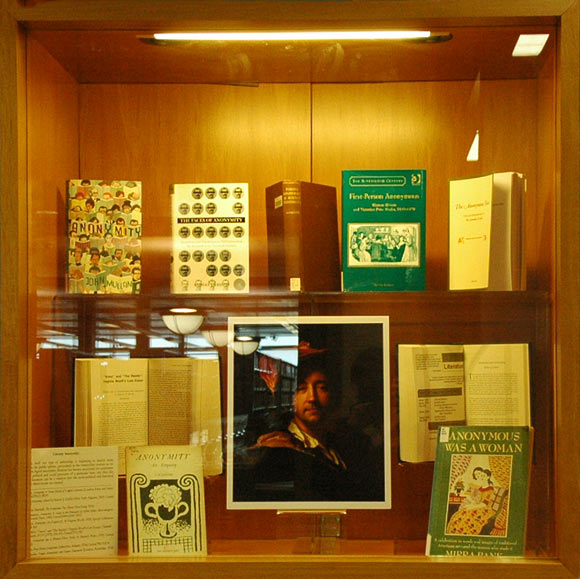Vitrine One: Literary Anonymity

Anonymity, itself one type of authorship, is beginning to receive more attention in the public sphere, particularly in the twenty-first century as we grapple with digital anonymity. Reasons for literary anonymity are sometimes specific to political and social pressures of a particular time, and thus this feature of literature can be a window into the socio-political and historical contexts in which books are created.
John Mullan, Anonymity: A Secret History of English Literature (London: Faber and Faber, 2007) Central PR121.MY43
The Faces of Anonymity, edited by Robert J. Griffin (New York: Palgrave, 2003) Central PR121.F347
Simone Celine Marshall, The Anonymous Text (Bern: Peter Lang, 2011)
Maurice Natanson, Anonymity: A Study in the Philosophy of Alfred Schutz (Bloomington: Indiana University Press, 1986) Central B945.S3544 N832
E. M. Forster, Anonymity: An Enquiry (L. & Virginia Woolf, 1925) Special Collections PR6011.O58 A67
Brenda R. Silver, ‘“Anon” and “The Reader”: Virginia Woolf’s Last Essays,’ Twentieth Century Literature, 25.3/4 (1979), 356-441, Central PN2.T83
Mirra Bank, Anonymous was a Woman (New York: St Martin’s Press, 1979) Central NK806.AL19
Alexis Easley, First Person Anonymous (Aldershot, Ashgate, 2004) Central PR115.E35
Arthur J. Quirke, Forged, Anonymous and Suspect Documents (London: Routledge, 1930) Storage HV8074.Q9
Robert J. Griffin, ‘Anonymity and Authorship,’ New Literary History 30.4 (1999), 877-895, Central PR1.N48

